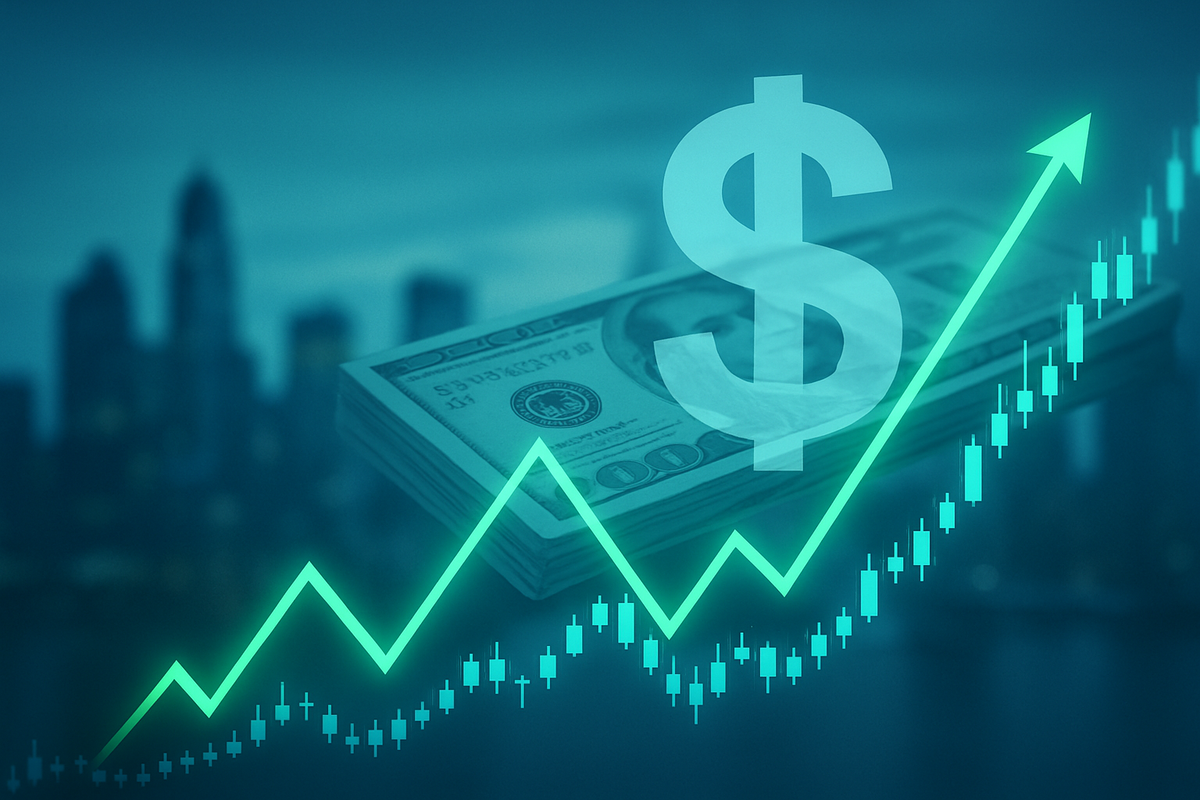Financial News
Treasury Yields and Dollar Climb as Inflation Report Shifts Market Dynamics

The financial markets are once again grappling with the persistent specter of inflation, as the latest reports have sent ripples through the bond market and currency exchange rates. Following a series of economic data releases, the yield on the benchmark 10-year Treasury note has seen a notable climb, while the U.S. dollar index has demonstrated a strengthening trend. These movements underscore a significant shift in market dynamics, primarily driven by evolving expectations for the Federal Reserve's monetary policy and the ongoing battle against rising prices.
This immediate reaction from investors highlights a recalibration of interest rate expectations, as hotter-than-anticipated inflation figures temper hopes for imminent rate cuts. The implications are far-reaching, affecting borrowing costs for businesses and consumers, influencing corporate earnings, and reshaping the attractiveness of U.S. assets on the global stage.
Inflation's Tug-of-War: CPI vs. PPI and Their Market Repercussions
The recent market movements are a direct consequence of a nuanced interplay between two critical inflation indicators: the Consumer Price Index (CPI) and the Producer Price Index (PPI). Initially, the release of the July CPI report around August 12-13 offered a glimmer of hope for a more dovish Federal Reserve. Headline inflation held steady at 2.7% year-over-year, slightly below forecasts, and core CPI rose 0.3% month-over-month to 3.1%, just above predictions. This "softer-than-expected" CPI data led to an initial drop in the 10-year Treasury yield by approximately three basis points to 4.255%, as markets began to price in increased expectations for a Federal Reserve interest rate cut in September. The U.S. dollar also weakened, with the DXY trading at its lowest level since July 28, extending losses of 0.5% post-CPI release, largely due to the reduced urgency for higher interest rates.
However, this narrative quickly reversed with the release of the July Producer Price Index (PPI) on August 14. The PPI report delivered a significant jolt, indicating that wholesale inflation was considerably hotter than anticipated, jumping 0.9% month-over-month and 3.3% year-over-year, well above economists' forecasts. This "hotter-than-expected" PPI data immediately tempered hopes for immediate rate cuts, leading to an upward adjustment in yields. The yield on the 10-year Treasury climbed to 4.26% from 4.20% just before the PPI data was released, and was recently observed at 4.27%. While the dollar's reaction to the PPI was more nuanced than its post-CPI weakening, generally, hotter inflation data that reduces the likelihood of immediate rate cuts tends to provide support for the dollar.
These movements underscore the market's sensitivity to inflation data, as it directly informs expectations for the Federal Reserve's monetary policy. When inflation appears persistent or is accelerating, investors demand a higher yield on fixed-income securities to compensate for the diminished purchasing power of future interest payments. This "inflation risk premium" pushes yields higher. Simultaneously, if the Federal Reserve is expected to maintain a tighter monetary policy (i.e., higher interest rates or fewer rate cuts) compared to other central banks, it makes U.S. dollar-denominated assets more attractive to foreign investors seeking higher yields, thereby strengthening the dollar. The key players in this scenario are the Federal Reserve, whose policy decisions are paramount, and bond traders and currency speculators who react swiftly to economic indicators.
Navigating the Shifting Tides: Potential Winners and Losers
The dual forces of rising Treasury yields and a strengthening U.S. dollar are creating a distinct landscape of winners and losers across various industries. These macroeconomic shifts directly influence borrowing costs, international trade, and investment flows, compelling companies to adapt their strategies.
Potential Winners:
The financial sector stands to be a primary beneficiary of rising interest rates. Banks, insurance companies, brokerage firms, and money managers typically thrive in such an environment. As Treasury yields climb, banks can charge more interest on loans (mortgages, credit cards, business loans) while the interest paid on deposits may increase at a slower rate, leading to wider profit margins. Insurance companies, holding substantial portfolios of interest-sensitive assets like bonds, will see higher returns on their investments. Companies like Allstate (NYSE: ALL), AmTrust Financial (NASDAQ: AFSI), and Travelers (NYSE: TRV) are well-positioned to flourish as rates rise. Similarly, Swiss Re (SWX: SREN) and Aviva (LSE: AV) are noted for healthy underwriting margins and improved investment results.
Domestically focused companies and U.S. importers are also likely to benefit from a strengthening dollar. A stronger dollar makes imported products and raw materials cheaper for U.S. businesses, which can significantly improve their profit margins. These cost savings can sometimes be passed on to consumers as lower prices, stimulating demand. Retailers that rely heavily on imported goods, such as Home Depot, Inc. (NYSE: HD) and off-price retailers like The TJX Companies (NYSE: TJX), are cited as potential beneficiaries. Companies with primarily domestic operations, such as utilities and Real Estate Investment Trusts (REITs), are less directly impacted by currency fluctuations and can be seen as more stable. Defense contractors like Lockheed Martin (NYSE: LMT) and healthcare giants like UnitedHealth Group (NYSE: UNH), with their significant government contracts and domestic focus, may also find themselves in a more favorable position.
Potential Losers:
Conversely, companies with high debt levels are particularly vulnerable to rising Treasury yields. Businesses heavily reliant on borrowing for operations, capital expenditures, or research and development will face increased costs, which can dampen revenue and earnings projections and lower valuations. This impact is especially pronounced for companies with variable-rate debt. The real estate sector, particularly residential, will also feel the pinch as higher interest rates directly translate to higher mortgage rates, making home purchases more expensive and potentially slowing down housing starts and sales.
U.S. exporters and multinational corporations with significant overseas revenue are likely to be negatively impacted by a strengthening U.S. dollar. A strong dollar makes U.S. products more expensive for foreign buyers, reducing demand and competitiveness abroad. Furthermore, when foreign earnings are converted back into a stronger U.S. dollar, their value decreases, directly impacting corporate profits. Giants like McDonald's Corp. (NYSE: MCD) and Philip Morris International Inc. (NYSE: PM), with a large percentage of sales overseas, are examples of companies that can be hurt. Other multinational corporations such as Nike (NYSE: NKE), Costco Wholesale Corp. (NASDAQ: COST), Walmart Inc. (NYSE: WMT), Johnson & Johnson (NYSE: JNJ), Procter & Gamble (NYSE: PG), Microsoft Corp. (NASDAQ: MSFT), and Apple Inc. (NASDAQ: AAPL) could see their international earnings diminished. The technology sector, particularly high-growth companies that rely on significant financing for expansion, may also suffer as borrowing costs rise and valuations are pressured by a more attractive risk-free rate from Treasuries.
Industry Impact and Broader Implications: A Shifting Economic Landscape
The recent movements in Treasury yields and the U.S. dollar are not isolated events but rather integral components of broader industry trends and have significant ripple effects across the global economy. This event underscores the ongoing challenge of inflation and its profound influence on monetary policy, investment decisions, and corporate strategies.
This scenario fits into a broader trend of central banks globally grappling with persistent inflationary pressures. While some economies have seen inflation moderate, the "hotter-than-expected" PPI data in the U.S. suggests that the fight against rising prices is far from over. This could lead to a divergence in monetary policy among major economies. If the Federal Reserve maintains a tighter stance for longer, while other central banks consider easing, the interest rate differential could widen further, attracting more capital to the U.S. and strengthening the dollar even more. This divergence could create challenges for countries with weaker currencies, making their dollar-denominated debt more expensive to service and potentially leading to capital outflows.
The ripple effects on competitors and partners are substantial. For U.S. companies that compete globally, a stronger dollar makes their products less competitive in international markets, potentially leading to reduced sales and market share. Conversely, foreign competitors selling into the U.S. market may find their products more attractive due to the favorable exchange rate. Supply chains could also be impacted; while U.S. importers benefit from cheaper raw materials, U.S. manufacturers relying on exports might face headwinds.
From a regulatory and policy perspective, persistent inflation and the resulting market dynamics could intensify calls for fiscal prudence. Governments might face increased pressure to reduce deficits and manage national debt more effectively, as higher interest rates make borrowing more expensive. There could also be renewed scrutiny on trade policies, as a strong dollar can exacerbate trade imbalances. Historically, periods of rising interest rates and a strong dollar have often been associated with shifts in global capital flows and, in some cases, increased financial market volatility. Comparisons can be drawn to periods in the early 1980s when the Federal Reserve aggressively raised rates to combat inflation, leading to a strong dollar and significant economic adjustments.
What Comes Next: Navigating Uncertainty and Opportunity
The immediate future for financial markets will largely hinge on the Federal Reserve's next moves and the trajectory of inflation. In the short term, markets will be highly sensitive to upcoming economic data, particularly subsequent inflation reports and employment figures. Any signs of persistent inflation could solidify the Fed's hawkish stance, leading to further increases in Treasury yields and continued dollar strength. Conversely, a significant deceleration in inflation could reignite hopes for rate cuts, potentially reversing some of the recent market movements.
In the long term, companies will need to strategically pivot and adapt to a potentially higher-for-longer interest rate environment and a persistently strong dollar. Businesses with significant debt burdens will need to prioritize debt reduction and explore alternative financing strategies. Exporters will need to find ways to enhance their competitiveness, perhaps through cost efficiencies, product innovation, or by expanding into new markets where the dollar's strength is less impactful. Domestically focused companies, particularly those in sectors like financials and certain retail segments, may find opportunities to expand and consolidate their market positions.
Market opportunities may emerge for investors who can identify companies resilient to these macroeconomic pressures or those that stand to benefit. This could include investments in financial institutions, companies with strong balance sheets and low debt, and businesses that primarily serve the domestic market. Challenges will undoubtedly arise for highly leveraged companies, multinational exporters, and sectors sensitive to consumer borrowing costs, such as real estate.
Potential scenarios and outcomes range from a "soft landing" where inflation gradually subsides without a severe economic downturn, allowing the Fed to eventually ease policy, to a more challenging "hard landing" where aggressive rate hikes trigger a recession. Another scenario involves "stagflation," where high inflation persists alongside stagnant economic growth. Investors should closely watch for shifts in the Federal Reserve's rhetoric, changes in inflation expectations, and the performance of key economic indicators to gauge the most likely path forward.
Conclusion: A New Chapter in Market Dynamics
The recent climb in Treasury yields and the strengthening of the U.S. dollar, spurred by the latest inflation report, mark a significant chapter in the ongoing narrative of financial market dynamics. The immediate takeaway is clear: inflation remains a formidable force, and its trajectory will continue to dictate the pace and direction of monetary policy. The "hotter-than-expected" PPI data has effectively tempered market expectations for imminent rate cuts, pushing borrowing costs higher and bolstering the dollar's value.
Moving forward, the market will remain highly sensitive to incoming economic data, particularly inflation and employment figures, as these will be the primary determinants of the Federal Reserve's next policy decisions. Investors should be prepared for continued volatility and potential shifts in market sentiment. Companies, especially those with significant international exposure or high debt levels, will need to demonstrate agility and strategic foresight to navigate this evolving landscape.
The lasting impact of these events could be a recalibration of investment strategies, with a renewed focus on companies with strong fundamentals, robust balance sheets, and a clear competitive advantage in a higher interest rate environment. What investors should watch for in the coming months includes the Federal Reserve's communications, the evolution of inflation metrics, and the performance of key economic sectors. The interplay of these factors will ultimately shape the market's trajectory and determine the long-term winners and losers in this new economic chapter.
More News
View More




Recent Quotes
View MoreQuotes delayed at least 20 minutes.
By accessing this page, you agree to the Privacy Policy and Terms Of Service.



